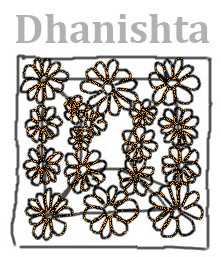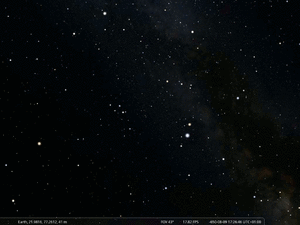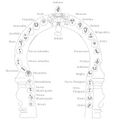Dhanishta: Difference between revisions
No edit summary |
No edit summary |
||
| (3 intermediate revisions by the same user not shown) | |||
| Line 1: | Line 1: | ||
{{DISPLAYTITLE: Dhaniṣṭhā (श्रविष्ठा)}} |
{{DISPLAYTITLE: Dhaniṣṭhā (श्रविष्ठा)}} |
||
[[File:23 Dhanishta draw.png|thumb|Dhanishta is the 23rd nakshatra.]] |
|||
| ⚫ | |||
[[File:Dhanishta nakshatras in Temple draw+lbl 4ase.jpg|thumb|Dhanishta, the 23rd nakshatra, in Tirupperunthurai (Athmanathaswamy temple) near Aranthangi, India, 10th century CE. (SMH 2025).]] |
[[File:Dhanishta nakshatras in Temple draw+lbl 4ase.jpg|thumb|Dhanishta, the 23rd nakshatra, in Tirupperunthurai (Athmanathaswamy temple) near Aranthangi, India, 10th century CE. (SMH 2025).]] |
||
| ⚫ | |||
Dhaniṣṭhā (श्रविष्ठा), "most famous", is an Indian name, used by the Indian Vedic tradition. Most of these names are roughly 3000 years old. They pre-date Hinduism but were taken over by it. |
Dhaniṣṭhā (श्रविष्ठा), "most famous", is an Indian name, used by the Indian Vedic tradition. Most of these names are roughly 3000 years old. They pre-date Hinduism but were taken over by it. |
||
| Line 21: | Line 20: | ||
The standard identification is the group of the brightest stars in Delphinus: α, β, γ, δ Delphini |
The standard identification is the group of the brightest stars in Delphinus: α, β, γ, δ Delphini |
||
====Stars within the Constellation Area==== |
|||
{| class="wikitable sortable mw-collapsible" |
|||
|+ |
|||
|- |
|||
!id |
|||
!Label |
|||
!IAU design. |
|||
!description |
|||
!Vmag |
|||
|- |
|||
|1 |
|||
|Rotanev |
|||
|HIP 101769 |
|||
|Constellation lines (Vertex) |
|||
|3.63 |
|||
|- |
|||
|2 |
|||
|Sualocin |
|||
|HIP 101958 |
|||
| Constellation lines (Vertex) |
|||
|3.8 |
|||
|- |
|||
|3 |
|||
|Aldulfin |
|||
|HIP 101421 |
|||
|Constellation lines (Vertex) |
|||
|4.03 |
|||
|- |
|||
| 4 |
|||
|γ 2 Delphini |
|||
|HIP 102532 |
|||
|Constellation lines (Vertex) |
|||
|4.25 |
|||
|- |
|||
|5 |
|||
|δ Delphini |
|||
|HIP 102281 |
|||
|Inside the hull |
|||
| 4.417 |
|||
|- |
|||
|6 |
|||
|κ Delphini |
|||
|HIP 101916 |
|||
|Constellation lines (Vertex) |
|||
|5.07 |
|||
|- |
|||
|7 |
|||
| ι Delphini |
|||
|HIP 101800 |
|||
|Inside the hull |
|||
|5.418 |
|||
|- |
|||
|8 |
|||
|θ Delphini |
|||
|HIP 101882 |
|||
|Inside the hull |
|||
|5.71 |
|||
|- |
|||
|9 |
|||
|10 Del |
|||
|HIP 102080 |
|||
|Inside the hull |
|||
|5.998 |
|||
|- |
|||
| 10 |
|||
| - |
|||
|HIP 101966 |
|||
| Inside the hull |
|||
|6.385 |
|||
|} |
|||
===Transfer and Transformation of the Constellation=== |
===Transfer and Transformation of the Constellation=== |
||
<gallery> |
<gallery> |
||
| Line 27: | Line 96: | ||
File:Nakshatras in Temple draw+lbl 4ase.jpg|Display of all 28th nakshatras in a door frame in Tirupperunthurai (Athmanathaswamy temple) near Aranthangi, India, 10th century CE. (SMH 2025). |
File:Nakshatras in Temple draw+lbl 4ase.jpg|Display of all 28th nakshatras in a door frame in Tirupperunthurai (Athmanathaswamy temple) near Aranthangi, India, 10th century CE. (SMH 2025). |
||
File:Tibet nakshatra 22.png|Dhanishta Tibetean |
File:Tibet nakshatra 22.png|Dhanishta Tibetean |
||
File:虚宿(仏像図彙).png |
|||
File:虚宿(仏像図彙).png|Dhanishta Chinese |
File:虚宿(仏像図彙).png|Dhanishta Chinese |
||
File:Traditional indonesian drums.jpg|Dhanishta Indonesian drum |
File:Traditional indonesian drums.jpg|Dhanishta Indonesian drum |
||
| Line 49: | Line 117: | ||
[[Category:Eurasia]] |
[[Category:Eurasia]] |
||
[[Category:South Asian]] |
[[Category:South Asian]] |
||
[[Category:Zodiac]] |
|||
Latest revision as of 17:26, 14 December 2025
Dhaniṣṭhā (श्रविष्ठा), "most famous", is an Indian name, used by the Indian Vedic tradition. Most of these names are roughly 3000 years old. They pre-date Hinduism but were taken over by it.
Etymology and History
Name Variants
- Dhaniṣṭhā
- Dhanishta
- Vāsava,
- Vasubha,
- Śraviṣṭhā ("the swiftest")
Origin of Constellation
The term "dhanishta" literally means "most famous" which may refer to the recognizable shape of stars of Delphinus that are identified here. An laternative name is Shravishthā, "swiftest".
Its depiction in temples displays a huge jar containing exactly 100 small stars, likely symbolizing the stream of the Milky Way next to the asterism in Delphinus with which the jar-like form perfectly and recognizably matches. For whatever reason (not given here) here are exactly 100 stars in the jar (neighbouring the "100 physicians"-asterism Shatabhisa in the sky) and they are only inside the jar. This contrasts the depiction of Revati (रेवती) which is a jar with fewer star among which two are outside of the jar.
The standard identification is the group of the brightest stars in Delphinus: α, β, γ, δ Delphini
Stars within the Constellation Area
| id | Label | IAU design. | description | Vmag |
|---|---|---|---|---|
| 1 | Rotanev | HIP 101769 | Constellation lines (Vertex) | 3.63 |
| 2 | Sualocin | HIP 101958 | Constellation lines (Vertex) | 3.8 |
| 3 | Aldulfin | HIP 101421 | Constellation lines (Vertex) | 4.03 |
| 4 | γ 2 Delphini | HIP 102532 | Constellation lines (Vertex) | 4.25 |
| 5 | δ Delphini | HIP 102281 | Inside the hull | 4.417 |
| 6 | κ Delphini | HIP 101916 | Constellation lines (Vertex) | 5.07 |
| 7 | ι Delphini | HIP 101800 | Inside the hull | 5.418 |
| 8 | θ Delphini | HIP 101882 | Inside the hull | 5.71 |
| 9 | 10 Del | HIP 102080 | Inside the hull | 5.998 |
| 10 | - | HIP 101966 | Inside the hull | 6.385 |
Transfer and Transformation of the Constellation
Mythology
mnemonic tales and cultural significance
Weblinks
References
- References (general)












